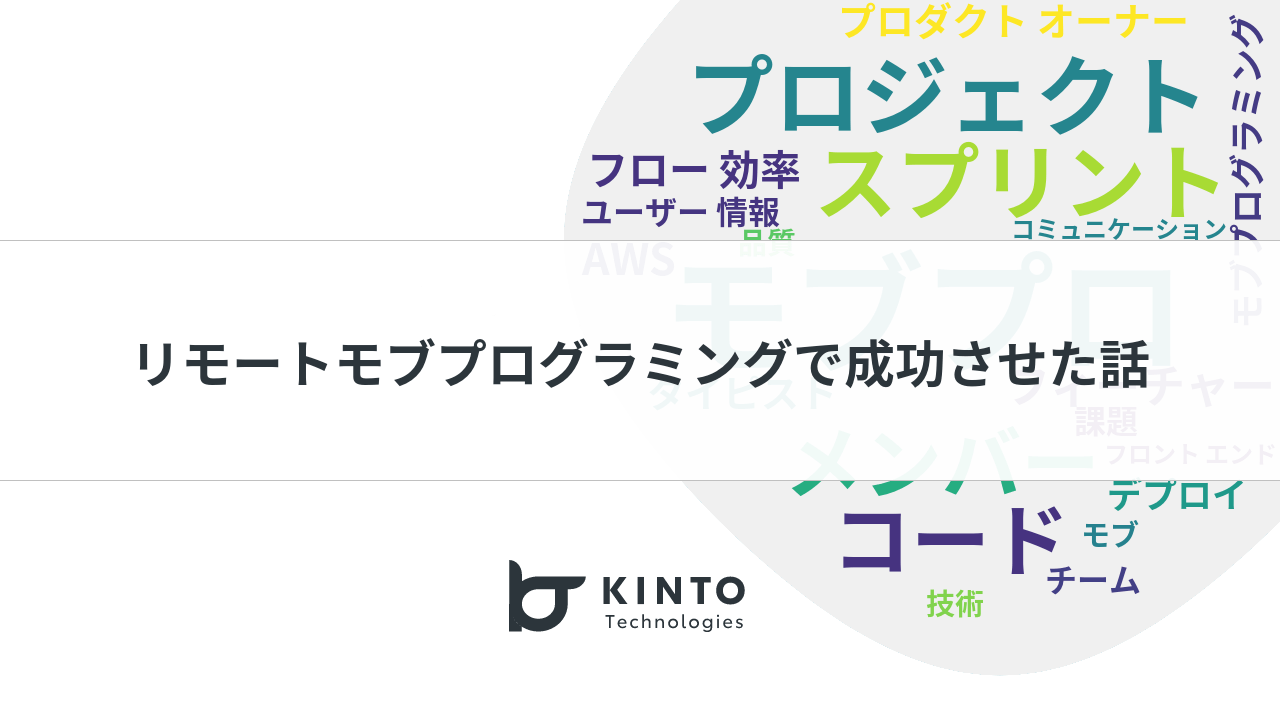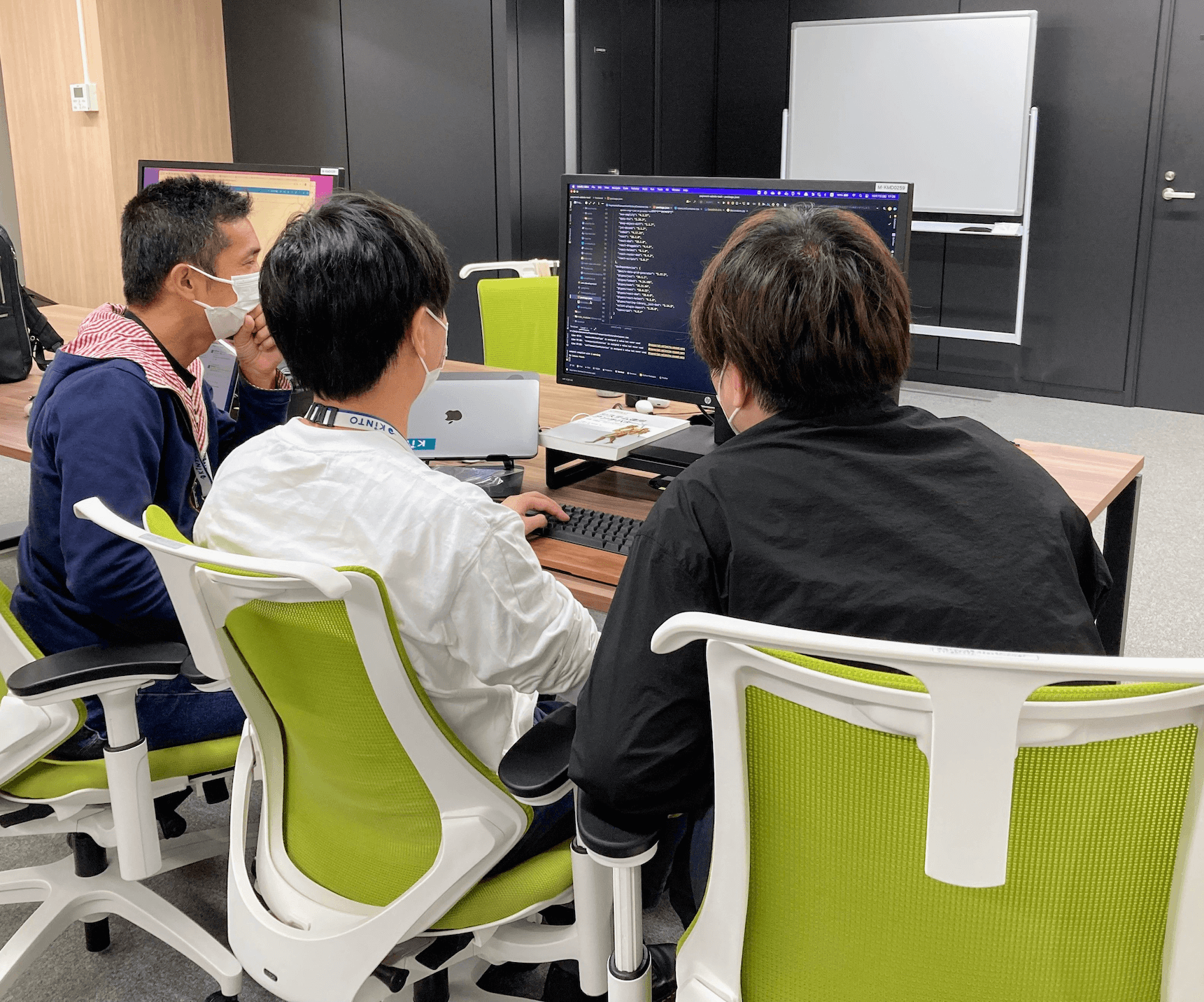入社1年未満メンバーだけのチームによる新システム開発をリモートモブプログラミングで成功させた話

はじめに
KINTOテクノロジーズで、複数のサービスが利用する決済プラットフォームの開発チーム[1]に所属している金谷です。 新規プロジェクトに対して、リモートでモブプログラミングを行い、オンスケジュールで開発完了させた事例を紹介します。
背景
社内向けの決済に関する業務システムを新規で作るプロジェクトが発足し、東京勤務のプロダクトオーナーと、東京勤務のエンジニアに、私含む大阪勤務の2名による3名のエンジニアの体制で開発することになりました。
素早く作りたいことと、運用コスト(特にAWSコスト)を減らしたいことから、フロントエンドにはAWS AmplifyをベースとしたReactによるSPAを採用し、いくつか必要なAPIの開発にはAWSサーバレスアプリケーションモデルを採用しました。
課題
プロジェクト開始直後の時点で、私は既に不安がありました。 具体的には、私自身が今まで使ったことのないAWSのサービスを使うことです。
自分の不安も共有するべくそれぞれのメンバーに話を聞くと、どうやら集まった3人は、技術的にも得意な領域が異なることが分かりました。 具体的には、フロントエンド・バックエンド・インフラ(AWS)の3領域に分けた場合、開発チームの各メンバーは、2つの領域は得意だが1つは自信がないことが分かりました。
例えばKさんこと私の場合、フロントエンドとバックエンドは大丈夫な反面、AWSに自信がない、といった具合です。奇跡的にも、各技術領域について2人は詳しい事が分かりましたので、誰かに頼り切りになる局面がなさそうだという点で安心しました。
| メンバー | フロントエンド | バックエンド | インフラ(AWS) |
|---|---|---|---|
| Kさん | ◎ | ◎ | △ |
| Tさん | ◎ | △ | ◎ |
| Nさん | △ | ◎ | ◎ |
スキルの領域と開発メンバーの得意領域の星取表
また会話する上で分かった一番の不安は、チームで開発していく上での共通認識がないことでした。 例えばフロントエンドだけでも、コンポーネントの粒度はどうするのか?状態管理はどの粒度で行うべきか?Promiseベースかasync/awaitで行くか?テストをどこまで書くべきか?などなど、コードが1行もない状況ですので、すべてを決めていく必要があります。一方で、入社後1年未満のメンバーで構成されたことから一緒に仕事をするのが初めてのメンバーなので、あのプロジェクトのように〜といった共通認識がありません。共通認識の構築はいち早く行う必要がありました。
改めて課題を整理しますと、プロジェクトを成功させるために、以下の2つが大きな課題であると考えました。
- 共通認識が揃っていない状況でスタートするため、共通認識を早めに構築したい (認識齟齬を減らし良い品質のプロダクトを作りたい)
- 各々の得意な領域を共有・補完することで、技術力を底上げしたい
上記2つの課題を解消するために、今回のプロジェクトでは、開発のスタイルとしてモブプログラミングを採用することにしました。
モブプログラミングとは
モブプログラミング(以下モブプロとします)とは、 モブプログラミング・ベストプラクティスという本では「3人以上の人々が1台のコンピューターの前に座って協力しながら問題を解決していくこと」とされています。
ひとつのPC(画面)で皆が参加するのですが、実際には2つのロールがあります。 3人以上で行うため、モブが2人以上いる状態で、議論しながら方針を決め、タイピストが方針に従いコードに落とし込みます。
- タイピスト (PCを操作しコードを書く)
- モブ (開発の方針を議論して指示する)
ひとつの仕事に3人以上が関わるモブプロを理解する上で、リソース効率とフロー効率という考え方が重要になります。詳細は フロー効率性とリソース効率性について #xpjug - SlideShareに譲りますが、モブプロはフロー効率に全振りする仕事の仕方です。
フロー効率最大化が目指したいことではないのですが、モブプロをする以上、フロー効率に軸足を置いた仕事の仕方になります。
試行錯誤した内容・工夫したこと
チームメンバーは地理的に離れている関係上、リモートでの開発を余儀なくされます。そのためZoomを使ったリモートモブプロが基本になります。
プロジェクトを成功させるために、課題の解消が必要だと考えていたため、以下の工夫をしながらモブプロを取り入れていきました。
情報量を増やす
情報量を増やすために、画面はタイピストのデスクトップ全体を共有しながら作業しました。共有ウィンドウだけでは、ウィンドウ外で何が起きているか分かりません。OSやツールの使い方も共有したいため、デスクトップ全体を共有しました。
次にタイピストは、考えていることをなるべく声に出しながら作業するようにしました。特に実際にアウトプットの作業を出来るのはタイピストだけなので、ズレがないかを確認する意図もあります。
気がつけば、タイピストも議論に加わることも多くなりました。 本来のモブプロのタイピストとは異なるのですが、共通認識を作ることが大事であると考えていたため、議論参加をヨシ!としていました。
時間を管理する
3人以上が自然に集まってモブプロすることは難しいと考えたため、カレンダーで各員の予定を押さえて、モブプロの時間を確保するようにしました。 モブプロの時間を事前に設定しておくことで、1日の開発にリズムが生まれやすくなります。
また、ZoomのTimerアプリを入れて、制限時間を設けるようにしました。モブプロは集中した作業のため、時間を区切らず続けてしまうことで疲労しやすくなります。適度な交代と適度な休憩を入れたいため、タイマーで時間管理するようにしました。書籍や他社事例 [2] を見ると10分交代と非常に短い時間で交代するようですが、次のタスク単位で分ける関係もあり、30分にしました。
フィーチャーチケットを更に細分化してTODO コメントとして残す
モブプロ対象のフィーチャーについて、作業を事前に細分化して、修正対象の中心となるソースコードに TODO コメントとして残すようにしました。
TODOコメントを残すには2つのメリットがあります。一つは、フィーチャーのゴールの解像度が上がること。もう一つは、区切りのいいタイミングで交代しやすくなることです。
例えば決済処理を行うユーザー情報の更新APIを新しく作る際に、以下のようなTODOコメントを、コードを書く前に書いていました。この時点で作業内容も作業順番もクリアになるため、段取り良く進める事ができますし、交代や休憩もスムーズでした。
# TODO openapiにユーザー情報更新の定義を追加
# TODO infrastructure - ユーザー情報更新のインターフェース作成
# TODO infrastructure - ユーザー情報更新の処理実装
# TODO application - バリデーション処理実装
# TODO application - ユーザー情報更新の処理実装
# TODO sam template に lambda 定義を追加
# TODO デプロイ、動作確認
def lambda_handler(event, context):
pass
モブプロする・しないの基準を相対的に設定する
すべてをモブプロで開発するのか?という疑問は早い段階で上がりましたが、実際にモブプロを進める上で、難しそう・議論が必要そうなフィーチャーを優先的にモブで実施することにしました。
あくまでスプリント内のフィーチャーのうち、相対的に難しそうなフィーチャーという選び方ではありますが、難しそうなフィーチャーに対する認識も揃ったため、皆に納得感がありました。
また簡単なフィーチャーは、モブプロ以外の時間で各自対応するようにしてバランスを取っていました。 難しそうなフィーチャーはモブプロで片付いているため、モブプロ終了後に簡単なフィーチャーのプルリクエストがガンガン飛んできました。
モブ「プログラミング」以外のこともモブプロで行う
モブプログラミングなので「プログラミング」だけを対象にしていたかというとそうではなく、プログラミング以外の作業もモブプロ時間にやっていました。例として2つ挙げます。
コードレビュー
コードレビューもモブプロでやっていることがありました。すべてをモブプロでやっていたわけではありませんので、どうしても開発過程を見ていないコードが出てきます。
モブプロの時間の最初に、モブプロ以外で作ったコードを説明する場を設けて、皆が聞いて質問するようにしました。この時間があったおかげで、詰まりがちなレビュー工程も素早くパスできました。
運用に関わる作業
運用に関する作業もモブプロの時間を使って行いました。具体的には、初めてCognitoのユーザープールを作るときや、GitHub Actionsに関する設定を追加するときには、モブプロの時間を使って皆で見ながら作業しました。これにより、運用面のイメージも付くようになりました。
プロダクトオーナーとのコミュニケーションをメンバー全員で出るようにする
開発チーム内の共通認識はできるようになったのですが、プロダクトオーナーも入れた会話がないとずれる恐れがありますし、実際にずれたことがありました。最初の頃は、プロダクトオーナーと私ではよく会話していたのですが、特に議事録も残さず意思決定も曖昧なまま進めていたため、認識のずれが発生していました。
対策として、プロダクトオーナーとのコミュニケーションは全員で参加するようにし、合わせて議事録もリアルタイムで残すようにしました。
以降は認識のずれも減ってきて、手戻りも少なく開発を進められるようになりました。
合わせて、お互い出張する機会を作り、重要な意思決定やオフラインでモブプロする機会を増やしました。

オフラインでモブプロする図
スプリントゼロを設ける (モブプロとは直接関係ない)
スプリントゼロを設けさせてほしいとプロダクトオーナーにお願いして、1週間のスプリントゼロ期間を作りました。
スプリントゼロでは、スプリント1でいきなり多くのアウトプットを出せるようにするための準備を行ったのですが、特に私がこだわりをもって行った作業は、以下の2点です。
- create-react-app が最低限動くリポジトリを作る
- create-react-appをデプロイできるようにデプロイ先やGitHub Actionsを整備する
つまり、開発環境でワンクリックで動作確認出来る状況を一番はじめに作りました。 継続的デプロイができることで、より良いフィードバックを素早く得ることができます。 継続的デプロイの仕組みを早い段階で作ったことで、いつでも誰でも開発環境に最新のコードをデプロイできるようになりました。それどころかスプリント0のスコープを飛び越えてスプリント1のフィーチャーを終わらせる人も出てきて嬉しい悲鳴でした。
モブプロとは直接の関係はありませんが、新規開発の際にスプリントゼロを設けるのはオススメです。 他にも準備することが盛りだくさんのスプリントゼロの詳細については 【資料公開】スクラムプロジェクト開始のベストプラクティス | Ryuzee.comをご参照ください。
結果の分析と次へのトライ
結果
プロダクトオーナーが求める品質を満たしつつ、オンスケジュールで開発を完了することができました。 その際、「これほどの高品質でスケジュール通り終わったプロジェクトは経験したことがなかった」とご評価いただきました。
また、利用者である業務部門のご担当者にも実際に画面を触っていただいてフィードバックを反映し、最終的に「とても使いやすい」とご評価いただきました。
我々開発メンバーも、苦手意識のある領域も自走できるようになりましたし、自分の強みを更に発揮する方向に進んでいます。
次に活かすための分析
プロジェクトとしては非常に良い成果を出すことができたと思いますが、再現性の高そうな理由を考えると、以下になると考えています。
- 共通認識を早い段階で揃えることにより、品質を高めて後戻りを減らすことができた
- スプリントゼロで開発の基盤を作ったことで、作業効率が最初から高くなっていた
- モブプロを通すことでコミュニケーションが多く発生し、早い段階で関係性構築ができた
総じて早期にコミュニケーションや開発基盤の構築など、よい準備ができたことが良かったのでしょう。
フロー効率に全振りするモブプロを積極的に行うことでスケジュールに遅れが出るのでは?と予想していましたが、そうなりませんでした。その理由として、難しい部分をモブプロで対応する一方で簡単な部分は各メンバーが対応したためではないか?と考えています。開発を進める上でのボトルネックとなる部分に集中できたことが良かったのでしょう。
次へのトライ
まずは自分たちだけで言いますと、自分たちだけでは解決できないときに、その問題を解決できる人と一緒にモブプロできるといいなと考えています。技術習得面でも、横のつながりの面でも、良い効果が得られそうだと考えています。
また、もう少し規模の大きいプロジェクトでもモブプロをやってみたいです。フロー効率全振りでは難しいという状況になるとは思いますが、まずは早い段階で共通認識を作ることがどのくらい良いのか?試してみたいです。
まとめ
フロー効率を最大化するモブプロですが、揃っていない共通認識を揃えるためにも非常に有用でした。難しい実装に集中してモブプロを行うように使い所を明確にすることで、プロジェクトの遅れを出さずに開発することができました。
KINTOテクノロジーズは、東京と大阪に開発拠点があります。どのような人たちが働いているのか?募集職種はどのようなものがあるのか?気になる方は、募集職種一覧をご覧ください。お待ちしております!
決済プラットフォームの他の取り組みは、 グローバル展開も視野に入れた決済プラットフォームにドメイン駆動設計(DDD)を取り入れた をご参照ください。 ↩︎
関連記事 | Related Posts

入社1年未満メンバーだけのチームによる新システム開発をリモートモブプログラミングで成功させた話

Rapidly Bringing iOS App Development In-House

Transforming Development Methodologies: Our Journey from Waterfall to Agile in Crafting the Prism Japan App

Introducing the Front End Team behind the Website Restructuring

What’s this 40-something person with no web experience doing here?
![Cover Image for Overcoming Challenges in the In-House Rollout of the 10X Innovation Culture Program [Part 1]](/assets/common/thumbnail_default_×2.png)
Overcoming Challenges in the In-House Rollout of the 10X Innovation Culture Program [Part 1]
We are hiring!
【プロジェクトマネージャー(iOS/Android/Flutter)】モバイルアプリ開発G/東京
モバイルアプリ開発GについてKINTOテクノロジーズにおける、モバイルアプリ開発のスペシャリストが集まっているグループです。KINTOやmy routeなどのサービスを開発・運用しているグループと協調しながら、品質の高いモバイルアプリを開発し、サービスの発展に貢献することを目標としています。
【ソフトウェアエンジニア(リーダークラス)】共通サービス開発G/東京・大阪・福岡
共通サービス開発グループについてWebサービスやモバイルアプリの開発において、必要となる共通機能=会員プラットフォームや決済プラットフォームなどの企画・開発を手がけるグループです。KINTOの名前が付くサービスやKINTOに関わりのあるサービスを同一のユーザーアカウントに対して提供し、より良いユーザー体験を実現できるよう、様々な共通機能や顧客基盤を構築していくことを目的としています。
